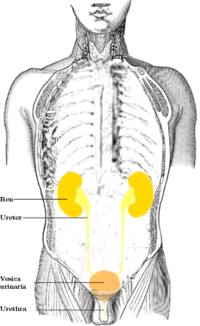
Photo from wikipedia
OBJECTIVE To evaluate the association of ureteral wall thickness (UWT) with spontaneous passage (SP) of ureteral stones and formation of ureteral stricture (US) in patients who underwent ureterorenoscopy for ureteral… Click to show full abstract
OBJECTIVE To evaluate the association of ureteral wall thickness (UWT) with spontaneous passage (SP) of ureteral stones and formation of ureteral stricture (US) in patients who underwent ureterorenoscopy for ureteral stones. STUDY DESIGN Cohort study. PLACE AND DURATION OF STUDY Department of Urology, University of Health Sciences, Bursa Yuksek Ihtisas Training and Research Hospital, Turkey, between January 2019 and June 2021. METHODOLOGY One hundred and sixty-nine patients with ureteral stones were restrospetively reviewed for maximum stone diameter, stone density, degree of hydronephrosis, parenchymal thickness, and UWT measurement from CT images. The patients were divided into two groups; patients who had (group 1) and had not (group 2) undergone SP of ureteral stones. These two groups were compared for stone characteristics and UWT. Ureterorenoscopy was performed on 52 patients who did not experience SP. Data related to the passage of guide wire and radio-opaque material, drainage method, ureteral wall injury and patients who developed US were recorded. Ureterorenoscopy group were divided into two groups of patients who did and did not develop stricture. These two groups were compared for stone characteristics and perioperative findings. RESULTS Of the 169 patients, 106 (62,7%) patients spontaneously passed stones. Ureterorenoscopy was performed on 52 patients. US developed in 9 (17%) patients. Maximum stone diameter, density, and antero-posterior (AP) diameter of the renal pelvis and UWT were statistically different between both groups. The degree of hydronephrosis, ureteral wall injury, density, AP diameter of the stones, parenchyma thickness, length of hospital stay, and UWT were found to be significantly increased in the stricture group. CONCLUSION UWT is a simple measurement that can be used to predict SP of ureteral stones. It can also predict the development of US after ureterorenoscopy in long-term. KEY WORDS Ureteral calculi, Ureterorenoscopy, Ureteral wall thickness, Ureteral stricture.
Journal Title: Journal of the College of Physicians and Surgeons--Pakistan : JCPSP
Year Published: 2023
Link to full text (if available)
Share on Social Media: Sign Up to like & get
recommendations!